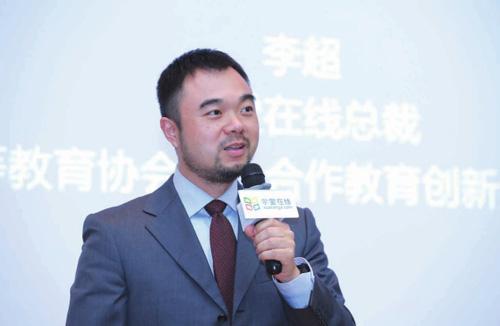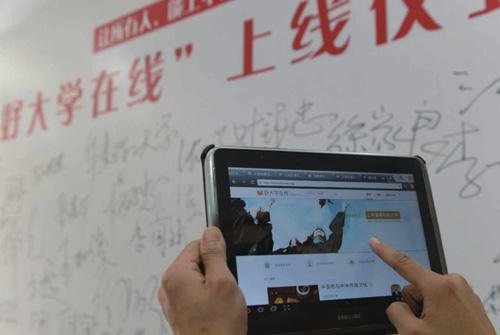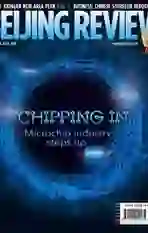Education Without Borders
2018-05-14ByJiJing
By Ji Jing


Mei Lixias first acquaintance with a MOOC—massive open online course—occurred in 2013 when she registered for courses on Coursera, the California-based course provider regarded as one of the biggest of its kind in the world.
The associate professor at Zhongnan University of Economics and Law in Wuhan City in central China enrolled for several courses and found Taiwan-based history professor Lu Shih- Haos lectures on Qin Shihuang (259-210 B.C.), the first emperor of a unified China, and The Records of the Grand Historian, an encyclopedic history of ancient China completed around 94 B.C., the most impressive.
Inspired by Lus lectures, Mei made up her mind to start an online course herself to spread knowledge and ideas to more people. In 2014, she attended a training session on MOOCs at Tsinghua University before starting her own MOOC with the help of colleagues and students. It was the fi rst MOOC at her university.
By September that year, her lectures titled Economic Geography and the Fate of Enterprises, which explore the relationship between the economic activities of enterprises and the environment, went up on Xuetangx.com, a MOOC platform run by MOOC-CN Information Technology (Beijing), a new company founded the same year.
Later, the course was uploaded to three other platforms. Today, it has around 100,000 registered learners. This year, the Ministry of Education (MOE) included it in its list of 490 national-level premium quality MOOCs.
The MOOC phenomenon, introduced in 2006 and becoming popular in 2012, came to China the next year. Since then, it has experienced explosive growth. Currently, there are 5,000 MOOCs in China and the number of registered MOOC users has reached 70 million, with over 11 million having received credits for their courses.
Lessons in transformation
Compared to traditional online courses, MOOC lectures, according to Mei, are divided into several carefully designed sections of 10 to 15 minutes each or shorter. They combine images, animations, videos, audio, graphics and exercises.
“Its like watching an American TV drama or movie,” Mei remarked. “Learning has become an enjoyable experience.”
Most MOOC platforms have Q&A; functions so that teachers and students can interact. They can also communicate through social networking platforms such as QQ and WeChat.
Jin Keyu, a government employee from Yueyang, a city in central China, took Meis course on Xuetangx.com in 2014 for over three months in his spare time. He said his horizons have been expanded by the course.
“The MOOC has enabled free access to high-quality educational resources, anytime, anywhere,” Jin said.
Xuetangx.com has become the third largest MOOC platform worldwide in terms of the number of courses available and registered users, according to a report by MOOC aggregator Class Central in December 2016. As of November last year, Xuetangx.com had over 9 million registered users and provided 1,300 courses from top universities both in China and abroad, including Tsinghua University and Stanford University, according to its website.
The platform is supported by the MOEs Research Center for Online Education. In addition to online courses, Xuetangx.com offers intelligent teaching tools such as the Rain Classroom, a free smartphone app devel-oped with Tsinghua University for teachers to share slides, videos and exams with students. Students send their feedback, helping instructors adjust their teaching strategies.
“New technologies such as virtual reality will also be used to improve the effi ciency and effectiveness of online teaching,” Yu Shijie, Deputy Director of the Research Center for Online Education, said.
According to MOE statistics, as of January there were over 10 MOOC providers in China like Xuetangx.com, offering courses from 460 universities.
Bridging inequality
The MOOC has been a cornucopia for Wang Xun, an 11-year-old primary school student living in a town in southwest China, where there are few extracurricular activities. Thanks to the MOOC, Wang can study paleography, bionics and cell biology after school on Icourse163.org.
The MOOC helps to bridge the gap in education quality between different universities as well as between developed and less developed regions. Hou Donglian, who works for a pharmaceutical company in Taizhou, a city in east China, is a student of Mei. Hou had always wanted to go to a prestigious university, and his MOOC course has compensated for his inability to do so, he said.
“Students have a wide variety of courses to choose from and they can make a choice based on their professional strengths or interest,” Hou told Beijing Review. “I will continue to take MOOC courses. You are never too old to learn.”
To promote educational resource sharing between universities in west and east China, 29 Chinese universities established WEMOOC in 2013, a league with over 100 members, including Peking University and Fudan University. Over the past fi ve years, students from nearly 2,000 universities have benefited from the initiative, which uses the online platform Zhihuishu.com.
Thanks to WEMOOC, students from institutions such as Tibet University in southwest China and Qinghai University in northwest China can access high-quality lectures from universities in east China. Teachers from less developed areas can also improve their teaching abilities from MOOC courses.
“In the past, there were a maximum of 500 to 600 students taking my course in an auditorium with some sitting on the fl oor. Now 160,000 students from over 600 universities have access to my online courses, which is unimaginable for a traditional classroom,” Ye Lang, a professor of philosophy at Peking University whose courses are available on Zhihuishu.com, told Peoples Daily.
“The Internet has provided new productivity to revolutionize education,” Ye added.
Drawbacks and remedies
However, MOOCs are far from perfect. Although Meis course has a large number of subscribers, few fi nish the course, a pervasive problem with the system.
“Many learners register out of interest. However, they lack the motivation and persistence to fi nish the course, sit the exam and receive the certifi cate,” Mei said, citing the data provided by Xuetangx.com. According to the data, only 3.5 percent of her students passed the exam.
To address the problem, Li Chao, President of MOOC-CN Information Technology (Beijing), said more diploma programs would be launched on Xuetangx.com to improve course completion rates. In addition, the MOE will accelerate Chinese universities recognition of credits obtained from MOOC courses, Song Yi, an MOE offi cial, said at a seminar in Beijing on April 21.
The high cost of developing MOOCs is another problem. Mei said her course cost 40,000 yuan ($6,327) to develop. The money, fortunately for her, came from her universitys funds allocated for educational reform. However, since the course went online, the only returns it can generate are a few thousand yuan from issuing certifi cates.
“Nevertheless, most teachers want to use MOOCs to reform teaching methods and influence more people, rather than seeking economic returns,” she said.
Now there is an online response tool on Xuetangx.com to ease the burden of answering questions online. Mei welcomes it, as she often feels overwhelmed interacting with so many students.
Song said the MOE would continue to promote the development of MOOCs to boost equal access to education. By 2020, the ministry will identify 3,000 national premium MOOCs and more measures will be rolled out to encourage teachers to adopt the new teaching method. As a rapidly developing sector, MOOCs will be subject to government supervision to improve content.
“The MOOC is becoming a key arena for countries to vie for dominance in the next round of higher education reform,” Wu Yan, head of the MOEs Department of Higher Education, said. “We should seize the opportunity to take the lead in the integration of information technology and education.”
Now Mei is preparing to make another MOOC called Assets Appraisal, which will be available in Chinese and English to reach international users.
Xuetangx.com is also eyeing internationalization. Currently 32 courses on the platform have been launched on EdX, a MOOC provider founded by Harvard University and the Massachusetts Institute of Technology in 2012.
